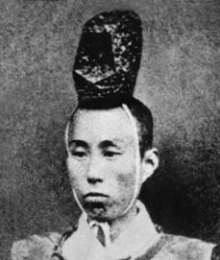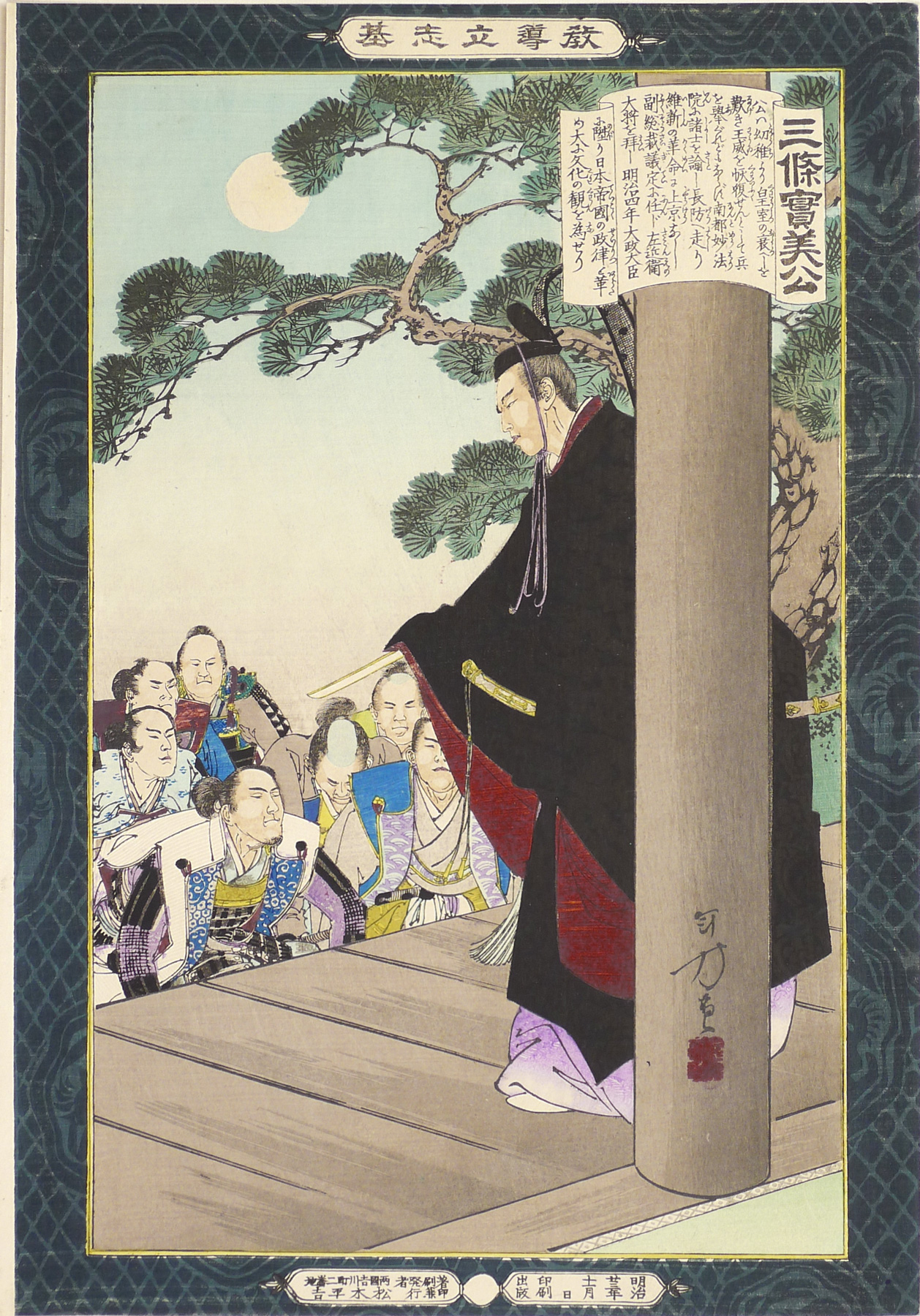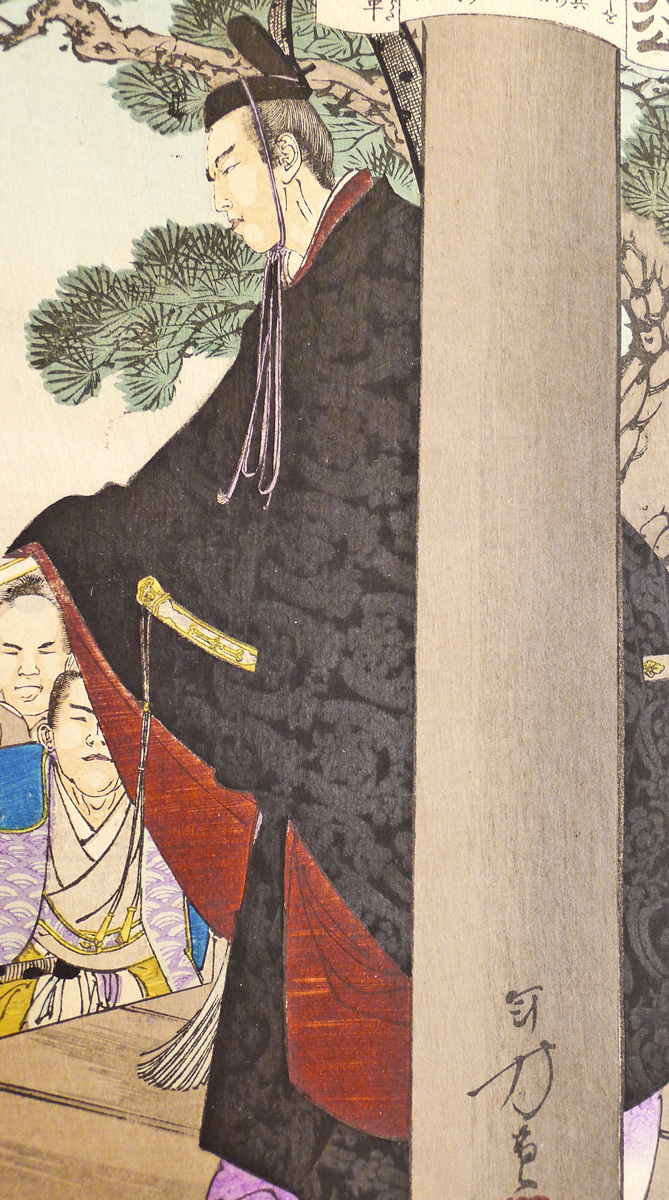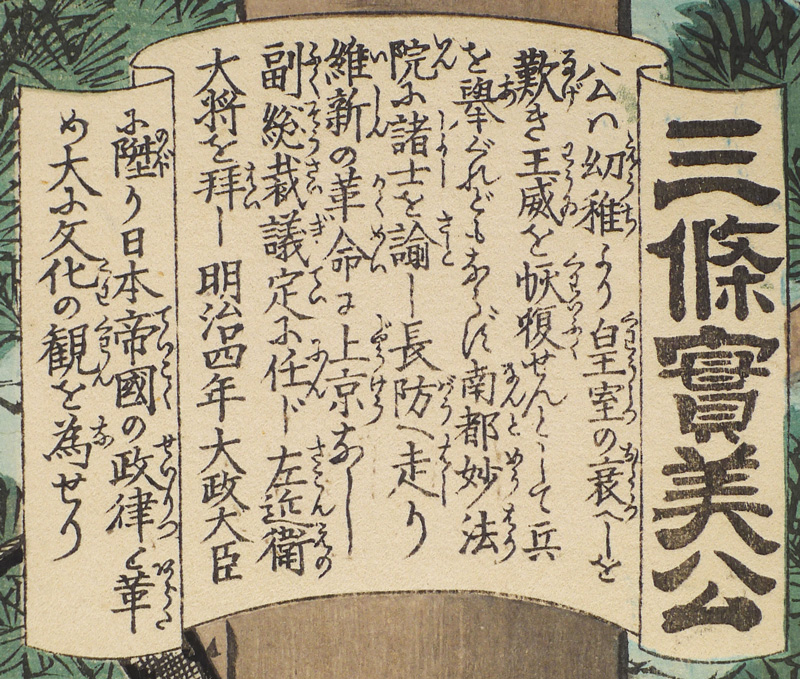About This Print
This unnumbered print1 in the series Instructive Models of Lofty Ambition pictures Sanjō Sanetomi (1837-1891), a nobleman who held several important posts in Emperor Kōmei's court, prior to the Meiji Restoration, and subsequently in Emperor Meiji's government. He is shown here reprimanding a group of rebellious samurai. While I have not deciphered the complete scroll contents (see Scroll Transcription below), I do see reference to several of the many government posts held by Sanetomi. The scene portrayed, while an artistic fabrication of the artist, likely references one of Sanetomi's trips to Satsuma, Choshu, or one of the other areas of samurai rebellion, to defend the new Meiji government.Note the detail in Sanetomi's robe, which is most visible when the print is tilted towards the light.
The artist Mizuno Toshikata contributed 16 prints to this series.
1 Numbering of the prints was haphazard during the production of the series. While this print is unnumbered, the title for this print is shown in the 50th position listed in the Table of Contents for this series (reference Table of Contents from the series Instructive Models of Lofty Ambition). Print numbers were sometimes inadvertently omitted; some prints in the series were never assigned numbers and a few of the same numbers appear on different prints.
Sanjo Sanetomi (1837-1891)
Source: National Diet Library website http://www.ndl.go.jp/portrait/e/datas/97.html?cat=8 undated photo of Sanetomi undated photo of Sanetomi | Noble and statesman. Born in Kyoto, a son of the Lord Keeper of the Privy Seal Sanetsumu Sanjo. He held several important posts in court. He was a central figure among the sonno joi group (supporters of the doctrine of revering the Emperor and expelling the barbarians) court nobles, but during the August 18 Incident which aimed to expel sonno joi group from Kyoto, he went down to Choshu as one of the Shichikyo-ochi (Seven nobles of decline). After the coup d'etat of osei fukko (restoration of Imperial rule) in 1867, he successively held important posts in the new government such as gijo (one of the three highest posts in the beginning of the Meiji government), vice-director-general, Udaijin (minister of the right), and director of the shushikyoku (Historical Compilation Bureau). He assumed the post of Dajo Daijin (Grand Minister of State) in 1871 and served until the abolition of the dajokan system in 1885. After the Cabinet system was established, he became Lord Keeper of the Privy Seal, and in 1889, when the Kuroda cabinet resigned en masse, he served concurrently as interim Prime Minister. |
Transcription of Scroll
Source: with thanks to Yajifun http://yajifun.tumblr.com/
“三條實美公 公ハ幼稚より皇室の衰へしを歎き王威を恢復せんとして兵を擧ぐれどもならず南都妙法院に諸士を諭し長防へ走り維新の革命に上京なし副総裁議定に任じ左近衛大将を拜し明治四年大政大臣に?(陛?のぼ)り日本帝國の政律を革め大に文化の観を為せり”
About The Series "Kyōdō risshi no motoi"
Notes:1. This series is variously translated as "Instructive Models of Lofty Ambition," "Foundations of Learning and Achievement," "Foundation of Instruction and Perseverance," "Self-Made Men Worthy of Emulation," "Paragons of Instruction and Success," "Moral of Success," "Examples of Self-Made Leaders," and "Instruction in the Fundamentals of Success." The title in Japanese is sometimes seen as "Kyōdō risshiki or "Kyōdō risshi no moto," in addition to the most commonly seen transliteration of "Kyōdō risshi no motoi".2. For a complete listing of all the prints in the series and additional information please see the article on this site titled Instructive Models of Lofty Ambition.
This series ran between October 1885 and November 1890 and featured a long list of heroes and heroines, from antiquity to contemporary times, who were regarded as standards of moral leadership and self-realization.
Source: Kiyochika Artist of Meiji Japan, Henry D. Smith II, Santa Barbara Museum of Art, 1988, p. 74-75; original research and as footnoted.
This series of 58 prints,1 plus a table of contents sheet (目録), were originally published between October 1885 and November 1890 by the Tokyo publisher Matsuki Heikichi 松木平吉.2 The table of contents sheet issued by the publisher states that "fifty prints make up the complete set (五十番揃)". Three prints not in the initial release were added over the five year publication period, as were five redesigns of original prints, eventually increasing the total print count to 58. The seven artists contributing prints were Kobayashi Kiyochika (1847-1915) [20 prints], Mizuno Toshikata (1866-1908) [16 prints], Inoue Tankei (Yasuji) (1864-1889) [13 prints], Taiso (Tsukioka) Yoshitoshi (1839-1892) [5 prints], Yōshū Chikanobu (1838-1912) [2 prints], Toyohara Kunichika (1835–1900) [1 print], and Hachisuka (Utagawa) Kuniaki II (1835-1888) [1 print]. All the artists, with the exception of Yōshū Chikanobu, are listed in the top scroll of the table of contents sheet. Various colors (including blue, blue/green, and tan/brown) were used for the decorative border, and in 1902 the series was re-issued by Matsuki without borders.
Brief texts contained within a scroll-like cartouche appearing on each print provide historical details. The scroll composer's name is given at the end of the scroll text. The “lofty ambition” of the title is a Confucian concept, originally from Mencius, meaning “righteous determination that would inspire others.” The market for the series probably included former samurai, ambitious youth, and conservative intellectuals.
"[W]hen it was completed in 1890 the publisher was singled out for special recognition by the government for having sponsored such noble subject matter."3
This series ran between October 1885 and November 1890 and featured a long list of heroes and heroines, from antiquity to contemporary times, who were regarded as standards of moral leadership and self-realization.
Source: Kiyochika Artist of Meiji Japan, Henry D. Smith II, Santa Barbara Museum of Art, 1988, p. 74-75; original research and as footnoted.
This series of 58 prints,1 plus a table of contents sheet (目録), were originally published between October 1885 and November 1890 by the Tokyo publisher Matsuki Heikichi 松木平吉.2 The table of contents sheet issued by the publisher states that "fifty prints make up the complete set (五十番揃)". Three prints not in the initial release were added over the five year publication period, as were five redesigns of original prints, eventually increasing the total print count to 58. The seven artists contributing prints were Kobayashi Kiyochika (1847-1915) [20 prints], Mizuno Toshikata (1866-1908) [16 prints], Inoue Tankei (Yasuji) (1864-1889) [13 prints], Taiso (Tsukioka) Yoshitoshi (1839-1892) [5 prints], Yōshū Chikanobu (1838-1912) [2 prints], Toyohara Kunichika (1835–1900) [1 print], and Hachisuka (Utagawa) Kuniaki II (1835-1888) [1 print]. All the artists, with the exception of Yōshū Chikanobu, are listed in the top scroll of the table of contents sheet. Various colors (including blue, blue/green, and tan/brown) were used for the decorative border, and in 1902 the series was re-issued by Matsuki without borders.
This series of 58 prints,1 plus a table of contents sheet (目録), were originally published between October 1885 and November 1890 by the Tokyo publisher Matsuki Heikichi 松木平吉.2 The table of contents sheet issued by the publisher states that "fifty prints make up the complete set (五十番揃)". Three prints not in the initial release were added over the five year publication period, as were five redesigns of original prints, eventually increasing the total print count to 58. The seven artists contributing prints were Kobayashi Kiyochika (1847-1915) [20 prints], Mizuno Toshikata (1866-1908) [16 prints], Inoue Tankei (Yasuji) (1864-1889) [13 prints], Taiso (Tsukioka) Yoshitoshi (1839-1892) [5 prints], Yōshū Chikanobu (1838-1912) [2 prints], Toyohara Kunichika (1835–1900) [1 print], and Hachisuka (Utagawa) Kuniaki II (1835-1888) [1 print]. All the artists, with the exception of Yōshū Chikanobu, are listed in the top scroll of the table of contents sheet. Various colors (including blue, blue/green, and tan/brown) were used for the decorative border, and in 1902 the series was re-issued by Matsuki without borders.
Brief texts contained within a scroll-like cartouche appearing on each print provide historical details. The scroll composer's name is given at the end of the scroll text. The “lofty ambition” of the title is a Confucian concept, originally from Mencius, meaning “righteous determination that would inspire others.” The market for the series probably included former samurai, ambitious youth, and conservative intellectuals.
"[W]hen it was completed in 1890 the publisher was singled out for special recognition by the government for having sponsored such noble subject matter."3
1 The Tokyo Metropolitan Library online collection shows 50 prints and a Table of Contents sheet. The Table of Contents lists the titles of 50 prints. Smith in Kiyochika Artist of Meiji Japan identified 52 prints. I have identified 58 prints from this series including five prints (Ikina, Michizane Sugiwara, Kesa Gozen, Soga Brothers and Hokiichi Hanawa) that were re-designed and re-printed, likely due to damaged or lost blocks.
2 Robert Schaap notes in Appendix II, p. 166 of Yoshitoshi, Masterpieces from the Ed Freis Collection, Chris Uhlenbeck and Amy Reigle Newland, Hotei Publishing, 2011 that the series originally appeared as newspaper supplements.
3 The World of the Meiji Print: Impressions of a New Civilization, Julia Meech-Pekarik, Weatherhill, 1986, p. 122.
1 The Tokyo Metropolitan Library online collection shows 50 prints and a Table of Contents sheet. The Table of Contents lists the titles of 50 prints. Smith in Kiyochika Artist of Meiji Japan identified 52 prints. I have identified 58 prints from this series including five prints (Ikina, Michizane Sugiwara, Kesa Gozen, Soga Brothers and Hokiichi Hanawa) that were re-designed and re-printed, likely due to damaged or lost blocks.
2 Robert Schaap notes in Appendix II, p. 166 of Yoshitoshi, Masterpieces from the Ed Freis Collection, Chris Uhlenbeck and Amy Reigle Newland, Hotei Publishing, 2011 that the series originally appeared as newspaper supplements.
3 The World of the Meiji Print: Impressions of a New Civilization, Julia Meech-Pekarik, Weatherhill, 1986, p. 122.
Print Details
| IHL Catalog | #1035 |
| Title or Description | Sanjō Sanetomi 三條實美公 (三条実美公) |
| Series | “Instructive Models of Lofty Ambition” (Kyodo risshiki 教導立志基) [note: series title also listed as 'Kyodo Risshi no Moto', ‘Kyodo risshi no motoi’, ‘Kyōdō risshi ki’ and variously translated as “Moral of success” or “Foundations of learning and achievement” or “Self-made Men Worthy of Emulation”' or “Examples of Self-made Leaders” or "Paragons of instruction and success"] |
| Artist | Mizuno Toshikata (1866-1908) |
| Signature |  |
| Seal | Toshikata seal 年方 as shown above |
| Publication Date | November 1890 明治廿三年十一月 日 |
| Publisher | Matsuki Heikichi (松木平吉) proprietor of Daikokuya Heikichi [Marks: seal not shown; pub. ref. 029] click on image to enlarge (from right to left) publishing and printing date: 明治廿三年十一月 日 印刷 出版 [Meiji 23 11th month, printing and publication] assigned number within series: number omitted publisher information: 著印刷兼発行者 両国吉川町二番地 松木平吉 [printer and publisher Ryōgoku Yoshikawachō 2-banchi Matsuki Heikichi] |
| Impression | excellent |
| Colors | excellent |
| Condition | excellent - original album backing; almost full-size |
| Genre | ukiyo-e; rishki-e; kyōiku nishiki-e |
| Miscellaneous | no editions of this print that I have seen carry a print number; position 50 in the Table of Contents for the series |
| Format | vertical oban |
| H x W Paper | 13 7/8 x 9 3/4 in. (35.2 x 24.8 cm) |
| H x W Image | 13 7/8 x 9 1/2 in. (35.2 x 24.1 cm) [12 1/2 x 8 in. (31.8 x 20.6 cm) area inside brocade border] |
| Literature | |
| Collections This Print | Tokyo Metropolitan Library 280-K21; Art Gallery of Greater Victoria 1996.006.001; Tokyo Digital Museum 96200411 |




